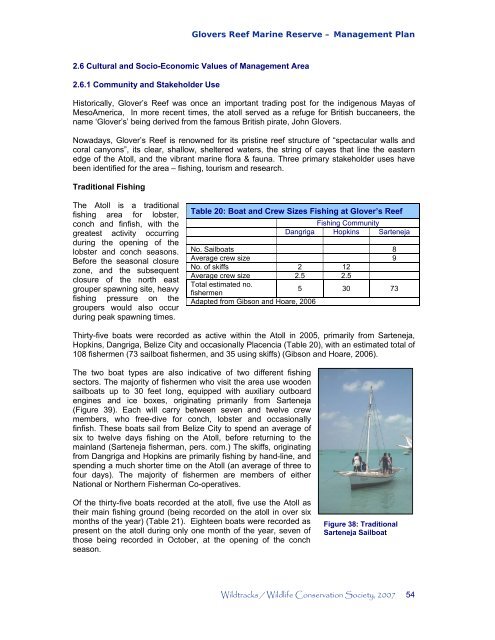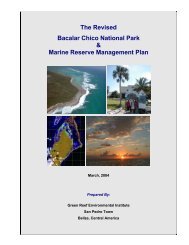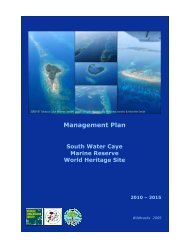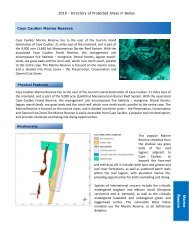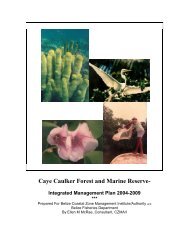Management Plan - Glover's Reef Marine Reserve
Management Plan - Glover's Reef Marine Reserve
Management Plan - Glover's Reef Marine Reserve
You also want an ePaper? Increase the reach of your titles
YUMPU automatically turns print PDFs into web optimized ePapers that Google loves.
Glovers <strong>Reef</strong> <strong>Marine</strong> <strong>Reserve</strong> – <strong>Management</strong> <strong>Plan</strong><br />
2.6 Cultural and Socio-Economic Values of <strong>Management</strong> Area<br />
2.6.1 Community and Stakeholder Use<br />
Historically, Glover’s <strong>Reef</strong> was once an important trading post for the indigenous Mayas of<br />
MesoAmerica, In more recent times, the atoll served as a refuge for British buccaneers, the<br />
name ‘Glover’s’ being derived from the famous British pirate, John Glovers.<br />
Nowadays, Glover’s <strong>Reef</strong> is renowned for its pristine reef structure of “spectacular walls and<br />
coral canyons”, its clear, shallow, sheltered waters, the string of cayes that line the eastern<br />
edge of the Atoll, and the vibrant marine flora & fauna. Three primary stakeholder uses have<br />
been identified for the area – fishing, tourism and research.<br />
Traditional Fishing<br />
The Atoll is a traditional<br />
fishing area for lobster,<br />
conch and finfish, with the<br />
greatest activity occurring<br />
during the opening of the<br />
lobster and conch seasons.<br />
Before the seasonal closure<br />
zone, and the subsequent<br />
closure of the north east<br />
grouper spawning site, heavy<br />
fishing pressure on the<br />
groupers would also occur<br />
during peak spawning times.<br />
Table 20: Boat and Crew Sizes Fishing at Glover’s <strong>Reef</strong><br />
Fishing Community<br />
Dangriga Hopkins Sarteneja<br />
No. Sailboats 8<br />
Average crew size 9<br />
No. of skiffs 2 12<br />
Average crew size 2.5 2.5<br />
Total estimated no.<br />
fishermen<br />
5 30 73<br />
Adapted from Gibson and Hoare, 2006<br />
Thirty-five boats were recorded as active within the Atoll in 2005, primarily from Sarteneja,<br />
Hopkins, Dangriga, Belize City and occasionally Placencia (Table 20), with an estimated total of<br />
108 fishermen (73 sailboat fishermen, and 35 using skiffs) (Gibson and Hoare, 2006).<br />
The two boat types are also indicative of two different fishing<br />
sectors. The majority of fishermen who visit the area use wooden<br />
sailboats up to 30 feet long, equipped with auxiliary outboard<br />
engines and ice boxes, originating primarily from Sarteneja<br />
(Figure 39). Each will carry between seven and twelve crew<br />
members, who free-dive for conch, lobster and occasionally<br />
finfish. These boats sail from Belize City to spend an average of<br />
six to twelve days fishing on the Atoll, before returning to the<br />
mainland (Sarteneja fisherman, pers. com.) The skiffs, originating<br />
from Dangriga and Hopkins are primarily fishing by hand-line, and<br />
spending a much shorter time on the Atoll (an average of three to<br />
four days). The majority of fishermen are members of either<br />
National or Northern Fisherman Co-operatives.<br />
Of the thirty-five boats recorded at the atoll, five use the Atoll as<br />
their main fishing ground (being recorded on the atoll in over six<br />
months of the year) (Table 21). Eighteen boats were recorded as<br />
present on the atoll during only one month of the year, seven of<br />
those being recorded in October, at the opening of the conch<br />
season.<br />
Figure 38: Traditional<br />
Sarteneja Sailboat<br />
Wildtracks / Wildlife Conservation Society, 2007 54


